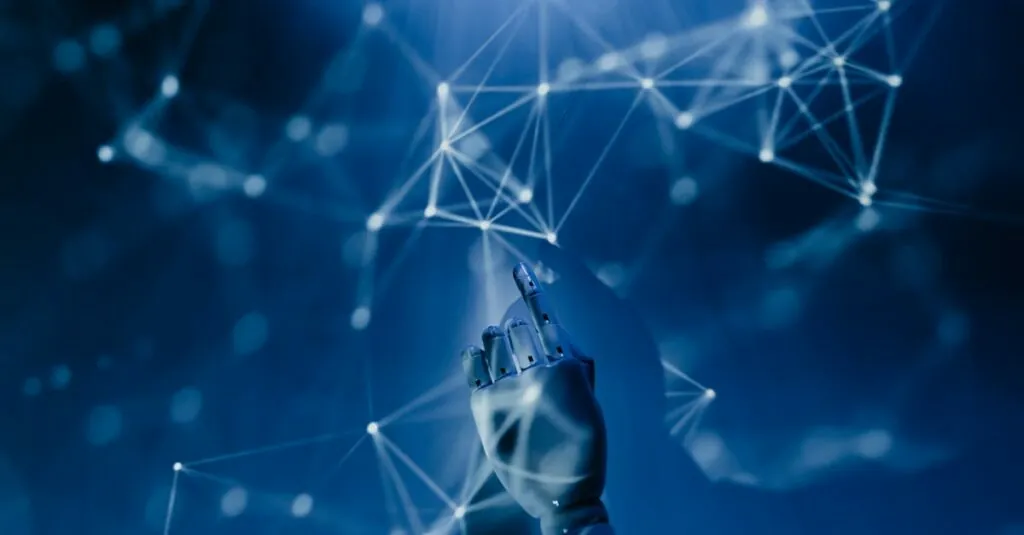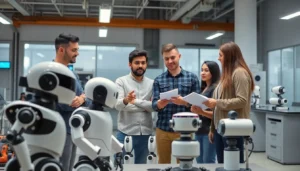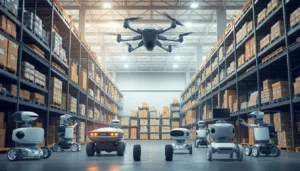In a world where robots are no longer just the stuff of sci-fi movies, automation is taking center stage in industries around the globe. Imagine a factory where machines work tirelessly, never asking for coffee breaks or vacation days. Sounds like a dream, right? Well, it’s reality, and it’s transforming how businesses operate.
Automation and robotics are revolutionizing everything from manufacturing to healthcare. They’re not just making processes faster; they’re making them smarter. With the ability to analyze data and adapt in real-time, these technological marvels are the new superheroes of the workforce. As they take on repetitive tasks, humans can focus on creativity and innovation—talk about a win-win! So, buckle up and get ready to explore the fascinating world of automation and robotics, where the future is both efficient and a little bit quirky.
Table of Contents
ToggleOverview of Automation and Robotics
Automation and robotics play vital roles in contemporary industry, significantly enhancing productivity. These technologies enable machines to perform tasks typically handled by humans, reducing errors and increasing operational speed. Flexible robotic systems integrate seamlessly into manufacturing environments, adapting to different tasks without extensive reconfiguration.
Artificial intelligence, a key component of modern robotics, drives advanced decision-making and learning capabilities. Robots can analyze data in real time, optimizing processes and improving quality control. This capability leads to reduced waste and improved efficiency across various sectors, from automotive to food processing.
In healthcare, automation streamlines administrative tasks, such as appointment scheduling and patient data management. Robots assist in surgeries, improving precision and reducing recovery times. This integration supports healthcare professionals, allowing them to focus more on patient care than routine tasks.
Statistics illustrate the growing impact of automation and robotics. According to the International Federation of Robotics, global robot sales continue to rise, reaching approximately 3 million units in 2020. Moreover, McKinsey Global Institute projects automation could raise productivity by up to 1.4% annually.
Industries benefit from embracing automation and robotics, achieving cost savings and higher quality outputs. By investing in these technologies, businesses position themselves for success in an increasingly competitive market. As automation evolves, it shapes the future workforce, encouraging the development of new skills and roles.
Key Technologies in Automation and Robotics
Automation and robotics rely on several key technologies that drive efficiency and enhance productivity across industries. Notably, advancements in these areas contribute to the evolution of modern work environments.
Artificial Intelligence
Artificial intelligence serves as a backbone for smart automation solutions. It enables machines to perform complex tasks with minimal human intervention. Algorithms process large datasets to identify patterns and derive insights, enhancing decision-making processes. In various applications, AI-powered systems improve predictive maintenance by analyzing equipment performance data, resulting in reduced downtime and operational costs. Companies that integrate AI into their workflow often experience significant boosts in overall efficiency.
Machine Learning
Machine learning plays a crucial role in refining automation processes. Through its ability to learn from data, it allows systems to adapt and improve over time. Various industries utilize machine learning for quality control, predicting product defects before they occur. This technology also facilitates continuous improvement by identifying inefficiencies within production lines, enabling organizations to optimize operations swiftly. Investing in machine learning sets the stage for businesses to innovate and respond to market demands effectively.
Internet of Things (IoT)
The Internet of Things connects devices and enables seamless communication between machines. Data generated from IoT devices aids real-time monitoring and control of automated systems. This interconnectedness empowers industries with substantial data analytics capabilities, allowing them to make informed decisions. In smart manufacturing, IoT technologies enhance visibility across supply chains, enabling prompt responses to potential issues. Harnessing the IoT fosters greater collaboration between equipment, resulting in streamlined operations and improved productivity.
Applications of Automation and Robotics
Automation and robotics anchor significant transformations across various sectors, playing a pivotal role in enhancing efficiency and productivity.
Manufacturing Industry
Manufacturing benefits immensely from automation and robotics. Machines take over repetitive tasks, allowing human workers to engage in more complex responsibilities. Robotics streamline assembly lines, improving accuracy and speed. Data indicates industries utilizing automation can boost productivity by as much as 1.4% annually. Flexible manufacturing systems adapt easily to various tasks, reducing downtime during reconfiguration. Automated inspections ensure product quality and reduce defects. Overall, robotics in manufacturing lead to higher output and efficiency.
Healthcare Sector
In healthcare, automation and robotics reshape patient care. Robots assist during surgeries, enhancing precision and minimizing recovery times. Automation handles repetitive administrative tasks, such as scheduling and billing, freeing up staff for direct patient interactions. Advanced technologies enable real-time data analytics for better decision-making and patient outcomes. Studies illustrate that integrated automation in healthcare improves overall operational efficiency. Healthcare professionals can focus on providing quality care when machines manage routine tasks, which enhances patient satisfaction.
Transportation and Logistics
Transportation and logistics leverage automation to streamline operations. Automated vehicles and drones efficiently manage delivery processes, improving speed and reducing errors. Furthermore, logistics centers use robotics to handle inventory management, ensuring accuracy and timeliness. Data-driven decision-making optimizes routes and reduces operational costs. Companies implementing these technologies increase throughput and enhance customer service. The integration of automation provides significant advantages in tracking shipments and managing supply chains effectively.
Challenges and Considerations
Automation and robotics present unique challenges that require careful consideration for successful integration into industries.
Ethical Implications
Ethical implications of automation and robotics often become prominent discussions. Machines performing tasks traditionally done by humans raises concerns about job displacement and economic inequality. Decisions around algorithm biases in AI systems can also lead to unintended consequences. Ensuring transparency in automated decision-making processes is crucial, as it fosters trust among users and stakeholders. Various industries are encouraged to adopt ethical guidelines that prioritize human values alongside technological advancements.
Workforce Impact
Workforce impact of automation and robotics significantly alters employment landscapes. While automation boosts productivity by allowing machines to handle repetitive tasks, workers in affected roles may face job loss. Reskilling initiatives become vital for addressing these shifts, as they equip individuals with necessary skills for emerging roles in the technology-driven economy. Statistics indicate that over 14 million jobs in the U.S. could be affected by automation by 2030, emphasizing the need for proactive workforce planning. Adapting to these changes ensures organizations maintain a skilled labor force while maximizing the benefits of automation.
Future Trends in Automation and Robotics
Emerging trends in automation and robotics shape the landscape of various industries. Advancements in artificial intelligence enhance machine learning capabilities, allowing systems to adapt and learn from data. Increased integration of the Internet of Things (IoT) enables smarter devices that communicate seamlessly, optimizing operational efficiency and data collection in real time.
Robotics in healthcare continue to evolve, improving surgical precision and patient outcomes. Robots capable of assisting during complex surgeries reduce recovery times, enabling healthcare professionals to devote more attention to patient care. Enhanced automation streamlines workflow in hospitals, amplifying precision in both administrative tasks and clinical procedures.
In manufacturing, companies embrace collaborative robots, or cobots, designed to work alongside humans. Cobots increase productivity without replacing the workforce, allowing workers to focus on creative problem-solving. Continuous advancements in robot vision systems further improve quality control, ensuring products meet strict standards.
Logistics and transportation are seeing a notable shift with the rise of autonomous delivery vehicles and drones. These innovations optimize inventory management and accelerate delivery processes. Increased efficiency in last-mile delivery enhances customer satisfaction, driving new standards in service.
Challenges persist alongside opportunities. Ethical considerations regarding job displacement necessitate transparent automated decision-making. Addressing workforce disruption requires reskilling initiatives to prepare employees for roles emerging from automation.
The global robot market continues to grow, with a projected increase in robot sales reported by the International Federation of Robotics. Projections highlight automation’s potential to raise productivity by up to 1.4 percent annually, underscoring the necessity for industries to adapt and thrive. Embracing these trends places organizations at the forefront of an evolving economic landscape, ready to leverage automation for sustainable success.
The rise of automation and robotics is undeniably reshaping industries and redefining the future of work. As organizations adopt these technologies, they unlock new levels of efficiency and productivity. This transformation not only enhances operational capabilities but also opens doors for innovation and creativity among the workforce.
While the benefits are substantial, addressing the challenges posed by automation is crucial. Ethical considerations and the need for reskilling initiatives must be prioritized to ensure a smooth transition for workers. As industries continue to evolve, embracing these advancements will be essential for staying competitive in a rapidly changing economic landscape. The future is bright for those ready to adapt and harness the power of automation and robotics.










